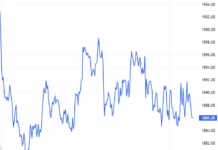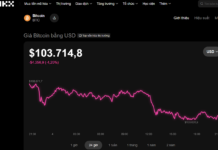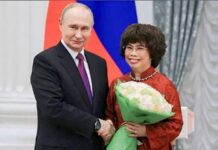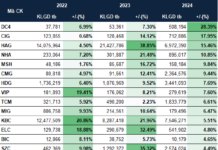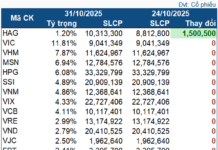International financial centers typically have high liquidity, well-developed legal frameworks, advanced technological infrastructure, and a concentration of skilled financial experts. They play an important role in capital intermediation and promoting international trade. International financial centers often attract global corporations, financial institutions, and investors, thereby enhancing the country’s standing as influential players in the global financial system.
VIETNAM NEEDS AN INTERNATIONAL FINANCIAL CENTER
International financial centers from New York, London to Tokyo, Frankfurt, Hong Kong, Singapore, and Shanghai have made significant contributions to the rapid development of their respective national economies.
In Vietnam, the establishment of Ho Chi Minh City as an international financial center has been discussed for several years, but there is still no specific action plan to realize this goal.
Of course, the rise of an economy is not necessarily tied to the emergence of an international financial center. A notable example is developed industrialized countries like South Korea or Italy, which have global banks and financial institutions, but do not achieve the status of financial centers like New York, London, Frankfurt, or Singapore.
Moreover, the competition to become an international financial center is fierce, posing significant challenges, particularly for a developing country like Vietnam. However, building a financial center will help Vietnam attract foreign financial institutions and capitalize on opportunities to attract international investment flows to Vietnam. This will have positive impacts on the capital supply, the lifeblood of the economy.
The process of building an international financial center also helps the financial market in Vietnam become healthy, efficient, and catch up with international standards, thereby promoting sustainable national economic development.
Controlling international financial centers requires comprehensive and coordinated approaches, including domestic regulations, international standards, supervisory cooperation, and effective enforcement mechanisms. The purpose is to maintain financial stability, protect investors, prevent financial crimes, and promote the integrity and soundness of the global financial system.
International financial centers establish a solid legal framework to ensure the integrity and stability of the financial market. For example, regulations protect investors, market conduct, capital requirements, risk management, and disclosure standards. These regulations are enforced and monitored to maintain market confidence.
Supervision aims to identify and mitigate risks, detect potential wrongdoings, and ensure the stability and soundness of financial institutions. International organizations such as the Financial Stability Board (FSB), the International Monetary Fund (IMF), and the Basel Committee on Banking Supervision formulate and promote international economic standards and best practices in financial regulation and supervision.

International financial centers encourage collaboration among market participants, regulatory agencies, and other relevant entities. This includes sharing information and coordinating efforts to address emerging risks and challenges. Enhanced cooperation improves market efficiency, promotes innovation, and strengthens the overall resilience of the financial system. Financial centers emphasize effective risk management measures. This involves monitoring and managing various risks, including credit risk, market risk, liquidity risk, and operational risk. A robust risk management framework helps minimize systemic risks and ensure the stability of the financial market.
Financial centers embrace innovation and leverage technology to enhance efficiency, accessibility, and security. They encourage the development and application of financial technology (fintech) to improve financial services, streamline processes, and expand access to financial products and services.
Aware of the importance of international cooperation and collaboration, financial centers often engage in dialogues with other financial centers, regulatory agencies, and international organizations to address global financial challenges, harmonize regulations, and promote cross-border cooperation.
5 KEY FACTORS DETERMINING THE FORMATION OF A FINANCIAL CENTER
There are 5 key factors determining the formation of a financial center: business environment, connectivity, human resources, financial infrastructure, and legal framework. Vietnam is gradually improving these factors.
Vietnam has experienced strong development since the economic reforms of the 1980s. According to the General Statistics Office, Vietnam’s economy reached VND 9,513 trillion (equivalent to USD 409 billion) in 2022, an increase of more than 10 times compared to 2000. The per capita GDP in 2022 at current prices is estimated at VND 95.6 million (equivalent to USD 4,110), an increase of USD 393 compared to 2021. In 2023 and 2024, the IMF forecasts that Vietnam’s GDP will rank fourth among ASEAN-6, reaching USD 462.64 billion and USD 615.6 billion, respectively.
Furthermore, Vietnam’s digital economy has the fastest growth rate in Southeast Asia, with the total value of goods increasing by about 28%, from USD 18 billion in 2021 to USD 23 billion in 2022. The growth rate is expected to reach 31% during the period 2022-2025. Vietnam is among the leading markets in terms of the adoption of future technologies, such as financial technology (fintech) and metaverse (cryptocurrencies, augmented reality, virtual reality, and NFT – non-fungible tokens), along with Indonesia and the Philippines. 58% of digital consumers in Vietnam have used fintech solutions (online banking, e-wallets, money transfer apps, etc.) in the past year.
Over the past two decades, Vietnam’s financial market has undergone positive transformations. Firstly, Vietnam’s banking system has become more dynamic and keeping pace with global management trends.
In the stock market, barriers to entry for foreign investors have been removed, making it more open and flexible. A notable example is the maximum foreign ownership limit for publicly listed companies in conditional investment and business sectors, except for some areas.
Notably, Ho Chi Minh City has many advantages to become an international financial center. The Ho Chi Minh City People’s Committee stated that the city accounts for only about 10% of the population and 0.63% of the country’s area, but it contributes the most to economic growth and the state budget.
Vietnam is in a different time zone than the 21 largest financial centers in the world. This is a special advantage in attracting idle capital during trading breaks from these centers. Ho Chi Minh City is not only in a different time zone but is also about a 3-hour flight from dynamic Asian economies like Singapore, Malaysia, Indonesia, Thailand, India, China, and the Philippines.
Building Ho Chi Minh City as an international financial center is a challenging but feasible task. Experience from previous international financial centers shows that it may take up to 10 years for Vietnam to achieve this goal.
To have an international financial center, Vietnam needs to address several issues: (1) building a transparent and in-depth market information system; (2) improving risk management structure and regulations to enhance competitiveness, including operational risk management (ORM), market risk management (MRM), particularly credit risk management (CRM); (3) creating conditions for credit rating agencies to operate actively, promoting transparency in the financial market, especially corporate bonds; (4) diversifying financial products in the market, especially in banking and insurance sectors; (5) having a legal framework to facilitate the development of fintech market; (6) establishing clear regulations for national digital currencies (CBDC), cryptocurrencies, and blockchain technology; (7) implementing appropriate capital control measures for a financial center; (8) investing in training a skilled financial workforce.
https://postenp.phaha.vn/chi-tiet-toa-soan/tap-chi-kinh-te-viet-nam


